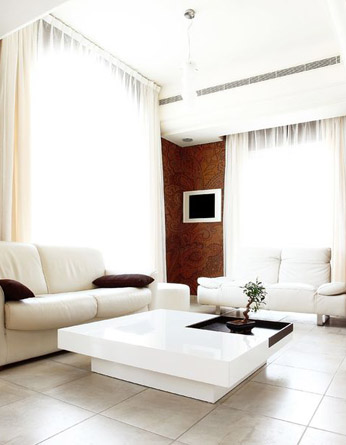Tile | Before You Buy
Smart shoppers take their time and collect all the facts before making a decision. Especially when it comes to the finishes you put in your home. Choosing the best ceramic tile for your home is really about knowing the right combination of characteristics, aesthetics, performance and budget to best meet the needs of your lifestyle.
The beauty of ceramic tile is the flexibility you have with design options, especially through the use of the accent pieces: trim work and decorative tiles.
Steps for trim work and decorative tile use
- identify the room and its application
- select the type of tile
- then its color and shade
- then its texture and size
- finally, a layout pattern is designed
- the trim and decorative patterns are determined
- grout color and type are chosen
Floor Tile Trims
Bullnose
- one rounded finished edge on the tile for a finishing
- sometimes it is also used as a substitute for cove base
Corner Bullnose
- two rounded finished edges on the tile to be used to complete a corner
Sanitary Cove Base
- rounded finished top like a bullnose to cover up the body of the tile
Color, texture and shading
- tiles are intended to show color and texture variations
- glaze also varies; different tile styles will also exhibit different gloss levels
- solid color tiles provide a consistent look
- shade variation is inherent in all fired ceramic products
- certain tiles will show greater variation within their dye lots
- shade variation is usually listed on the back label of each sample
- low, moderate, high or random rating
- color of the body of the tile is determined by the color of the clay
- quality of the tile is more related to the quality of the manufacturer, not the color of the body
- color variations will also be present between manufacturers’ samples
Low (V1). Consistent shade and texture
Moderate (V2)
- moderate shade and texture variation
High (V3)
- high shade and texture variation
Random (V4)
- high shade and texture variation
Moisture absorption and tile density
As the composition of glaze varies, different styles of tile will exhibit different gloss levels and surface textures. This is important to note when choosing your ceramic tile flooring. For example, in areas that are used while wet, such as your shower or bathroom floor, they should have low moisture absorption and good slip resistance.
Moisture Absorption
- as the density of the tile increases, the amount of moisture that tile can absorb becomes less
Tile Density
- as the weight or the density of the tile increases, it becomes a stronger tile
- density of the tile increases the moisture absorption rate becomes less
Non-Vitreous Tiles
- tiles that absorb 7% or more moisture
- suited for indoor use only
Semi-Vitreous Tiles
- tiles that absorb from 3% to 7% moisture
- applicable for indoor use only
Vitreous Tiles
- tiles that absorb less that 3% moisture
- referred to as frost resistant tiles
- cannot be used in exterior areas where freeze
- thaw conditions could cause tile cracking
Impervious Tiles
- tiles that have less than .5% moisture absorption
- frost proof
- can be used in exterior areas or on the outside of building facades
Grout
- typically mixed on site
- slight color variations can occur within different areas of the same installation with the same grout color
- can vary from the manufacturer’s sample
- attributed to variations in temperature and humidity at the time of grouting
- common to see grout variations when comparing the grout color in a tile floor and the same grout color on the tile countertop or wall
- select a color that blends in with the overall color of the tile to minimize the appearance of the grout
- select a grout color that is lighter or darker than the tile
- in high traffic areas, you may want to select a darker grout
- exact layouts, type of grout and grout joints widths are determined by the tile setter at the time of installation and are governed by the actual size and shape of the tile, and the exact dimensions of the areas to be covered
- your responsibility to maintain all caulked areas
- may also darken over time in areas with heavy water use
- changes of season can cause cracking and separation
Subfloors
- no subfloors are perfectly level
- may hear hollow sounds where your subfloor’s surface dips and ridges
- that this does not affect the integrity or installation
- hollow sounds are normal and are not considered defect
Cost of ownership – Potential additional expenses
- furniture removal/replacement
- demolition/disposal of old floor covering
- subfloor preparation
- product delivery
- ceramic tile installation
- materials required to complete the installation







